AES STANDARDS: DRAFT FOR COMMENT ONLY
DRAFT REVISED AES67-xxxx
STANDARDS AND
INFORMATION DOCUMENTS
Call for comment on
DRAFT REVISED
AES standard for
audio applications of networks -
High-performance streaming
audio-over-IP interoperability
This document was developed by a writing group of the Audio Engineering Society Standards Committee
(AESSC) and has been prepared for comment according to AES policies and procedures. It has been brought to
the attention of International Electrotechnical Commission Technical Committee 100. Existing international
standards relating to the subject of this document were used and referenced throughout its development.
Address comments by E-mail to standards@aes.org, or by mail to the AESSC Secretariat, Audio Engineering
Society, PO Box 731, Lake Oswego OR 97034. Only comments so addressed will be considered. E-mail is
preferred. Comments that suggest changes must include proposed wording. Comments shall be restricted to
this document only. Send comments to other documents separately. Recipients of this document are invited to
submit, with their comments, notification of any relevant patent rights of which they are aware and to provide
supporting documentation.
This document will be approved by the AES after any adverse comment received within six weeks of the
publication of this call on http://www.aes.org/standards/comments/, 2018-02-14 has been resolved. Any person
receiving this call first through the JAES distribution may inform the Secretariat immediately of an intention to
comment within a month of this distribution.
Because this document is a draft and is subject to change, no portion of it shall be quoted in any
publication without the written permission of the AES, and all published references to it must include a
prominent warning that the draft will be changed and must not be used as a standard.
AES STANDARDS: DRAFT FOR COMMENT ONLY
�
The AES Standards Committee is the organization responsible for the standards
program of the Audio Engineering Society. It publishes technical standards,
information documents and technical reports. Working groups and task groups with a
fully international membership are engaged in writing standards covering fields that
include topics of specific relevance to professional audio. Membership of any AES
standards working group is open to all individuals who are materially and directly
affected by the documents that may be issued under the scope of that working group.
Complete information, including working group scopes and project status is available
at http://www.aes.org/standards. Enquiries may be addressed to standards@aes.org
The AES Standards Committee is supported in part by those listed below who, as
Standards Sustainers, make significant financial contribution to its operation.
STANDARDS
This list is current as of 2017/7/25
�
AES67-xxxx
Revision of AES67-2015
aes67-r-171107-draft-rev-cfc-rc4.doc
DRAFT REVISED
AES standard for
audio applications of networks -
High-performance streaming
audio-over-IP interoperability
Published by
Audio Engineering Society, Inc.
Copyright ©2013, 2015, 2017, 2018 by the Audio Engineering Society
Abstract
High-performance media networks support professional quality audio (16 bit, 44,1 kHz and higher) with low
latencies (less than 10 milliseconds) compatible with live sound reinforcement. The level of network
performance required to meet these requirements is available on local-area networks and is achievable on
enterprise-scale networks. A number of networked audio systems have been developed to support high-
performance media networking but until now there were no recommendations for operating these systems in an
interoperable manner. This standard provides comprehensive interoperability recommendations in the areas of
synchronization, media clock identification, network transport, encoding and streaming, session description and
connection management.
An AES standard implies a consensus of those directly and materially affected by its scope and provisions and
is intended as a guide to aid the manufacturer, the consumer, and the general public. The existence of an AES
standard does not in any respect preclude anyone, whether or not he or she has approved the document, from
manufacturing, marketing, purchasing, or using products, processes, or procedures not in agreement with the
standard. Prior to approval, all parties were provided opportunities to comment or object to any provision.
Attention is drawn to the possibility that some of the elements of this AES standard or information document
may be the subject of patent rights. AES shall not be held responsible for identifying any or all such patents.
Approval does not assume any liability to any patent owner, nor does it assume any obligation whatever to
parties adopting the standards document. This document is subject to periodic review and users are cautioned to
obtain the latest edition. Recipients of this document are invited to submit, with their comments, notification of
any relevant patent rights of which they are aware and to provide supporting documentation.
Audio Engineering Society Inc. 551 Fifth Avenue, New York, NY 10176, US.
www.aes.org/standards standards@aes.org
AES STANDARDS: DRAFT FOR COMMENT ONLY
Page 1 of 70
�
AES STANDARDS: DRAFT FOR COMMENT ONLY
aes67-r-171107-draft-rev-cfc-rc4.doc
Contents
0 Introduction..........................................................................................................................................6
0.1 General............................................................................................................................................6
0.2 Patents.............................................................................................................................................6
1 Scope ....................................................................................................................................................7
2 Normative references............................................................................................................................7
3 Definitions and abbreviations................................................................................................................8
4 Synchronization..................................................................................................................................13
4.0 General..........................................................................................................................................13
4.1 IP network synchronization.............................................................................................................13
4.2 IEEE 1588 network synchronization ................................................................................................13
4.3 AVB network synchronization.........................................................................................................13
5 Media clocks .......................................................................................................................................13
6 Transport ...........................................................................................................................................14
6.0 General..........................................................................................................................................14
6.1 Network layer ................................................................................................................................14
6.2 Quality of service ...........................................................................................................................15
6.3 Transport layer...............................................................................................................................16
7 Encoding and streaming .....................................................................................................................17
7.0 Introduction ...................................................................................................................................17
7.1 Payload format and sampling rate ....................................................................................................17
7.2 Packet time ....................................................................................................................................17
7.2.0 General ...................................................................................................................................17
7.2.1 Required packet time................................................................................................................18
7.2.2 Recommended packet times......................................................................................................18
7.3 Stream channel count......................................................................................................................19
7.4 Link offset.....................................................................................................................................19
7.5 Sender timing and receiver buffering ...............................................................................................20
7.6 Multicasting...................................................................................................................................21
8 Session description..............................................................................................................................21
8.0 General..........................................................................................................................................21
8.1 Packet time ....................................................................................................................................21
8.2 Clock source..................................................................................................................................22
8.3 RTP and media clock......................................................................................................................23
8.4 Payload types.................................................................................................................................23
8.5 Example descriptions......................................................................................................................23
8.5.0 Errata......................................................................................................................................23
8.5.1 Multicast session description example .......................................................................................23
8.5.2 Unicast session description example..........................................................................................24
9 Discovery............................................................................................................................................24
10 Connection management...................................................................................................................24
10.0 General........................................................................................................................................24
10.1 Unicast connections......................................................................................................................24
10.1.1 SIP URI ................................................................................................................................24
10.1.2 Server and serverless modes....................................................................................................25
10.1.3 User-Agent............................................................................................................................25
10.1.4 Format negotiation .................................................................................................................25
10.1.5 Packet time negotiation...........................................................................................................25
10.2 Multicast connections ...................................................................................................................25
AES STANDARDS: DRAFT FOR COMMENT ONLY
Page 2 of 70
�
AES STANDARDS: DRAFT FOR COMMENT ONLY
aes67-r-171107-draft-rev-cfc-rc4.doc
Annex A (Normative) - Media profile.....................................................................................................26
A.0 General.........................................................................................................................................26
A.1 Media profile description ...............................................................................................................26
A.2 Media profile ................................................................................................................................26
A.2.1 Identification ..........................................................................................................................26
A.2.2 PTP attribute values ................................................................................................................26
A.2.3 PTP options............................................................................................................................28
A.2.4 Clock physical requirements ....................................................................................................29
Annex B (Informative) - Network QoS configuration recommendations ................................................30
B.0 General.........................................................................................................................................30
B.1 DiffServ network configuration.......................................................................................................30
B.1.1 Clock .....................................................................................................................................30
B.1.2 Media.....................................................................................................................................31
B.1.3 Best effort...............................................................................................................................31
Annex C (Informative) – AVB network transport..................................................................................33
C.0 General.........................................................................................................................................33
C.1 AVB network transport ..................................................................................................................33
C.1.1 Interoperable media as AVB time-sensitive streams ...................................................................33
C.1.2 Interoperable media as other traffic...........................................................................................34
Annex D (Informative) - Interfacing to IEEE 802.1AS clock domains ....................................................36
D.0 General.........................................................................................................................................36
D.1 Boundary clock interface................................................................................................................36
D.2 Ordinary clock interface.................................................................................................................36
D.3 Traceable reference........................................................................................................................36
D.4 AVB network as a boundary clock..................................................................................................37
Annex E (Informative) – Discovery systems ...........................................................................................38
E.0 General .........................................................................................................................................38
E.1 Bonjour.........................................................................................................................................38
E.2 SAP..............................................................................................................................................38
E.3 Axia Discovery Protocol.................................................................................................................38
E.4 Wheatstone WheatnetIP Discovery Protocol.....................................................................................38
E.5 AMWA NMOS Discovery and Registration Specification (IS-04) .....................................................39
Annex F (Informative) - Glossary ..........................................................................................................40
Annex G (Normative) - Protocol implementation conformance criteria..................................................42
G.1 Introduction ..................................................................................................................................42
G.2 Instructions for completing the PICS proforma ................................................................................42
G.3 PICS proforma ..............................................................................................................................43
G.3.1 Identification ..........................................................................................................................43
G.3.2 Synchronization ......................................................................................................................44
G.3.3 Media clocks .........................................................................................................................45
G.3.4 Transport................................................................................................................................46
G.3.5 Encoding and streaming...........................................................................................................49
G.3.6 Session description..................................................................................................................56
G.3.7 Clock source...........................................................................................................................58
G.3.8 Discovery...............................................................................................................................60
G.3.9 Connection management..........................................................................................................60
G.3.10 Media profile (Normative) .....................................................................................................61
G.3.11 Media profile ........................................................................................................................61
G.4 – Qualification criteria for encoding and streaming capabilities .........................................................69
Annex H Bibliography...........................................................................................................................70
AES STANDARDS: DRAFT FOR COMMENT ONLY
Page 3 of 70
�
AES STANDARDS: DRAFT FOR COMMENT ONLY
aes67-r-171107-draft-rev-cfc-rc4.doc
Foreword
This foreword is not part of the AES67-2013 AES standard for audio applications of networks - High-
performance streaming audio-over-IP interoperability
This document was developed in project AES-X192, in the SC-02-12-H task group on high-performance
streaming audio-over-IP interoperability, under the leadership of Kevin Gross.
Members of the writing group that contributed to this document in draft are: R. Abraham, J. Amate,
M. Barbour, C. Becker-Foss, J. Berryman, M. Bishop, H. Blum, J. Boqvist, T. Borland, N. Borthwick,
L. Bradshaw, P. Briscoe, L. Brito, J. Britton, C. Broad, N. Brunsgaard, D. Brutzman, E. Bukont Jr.,
A. Calvanese, R. Camprodon, M. Carter, A. Cedronius, A. Clark, H. Clarke, M. Coinchon, P. Cyrta,
S. de Jaham, P. Demuytere, J. Dibley, A. Dickens, P. Dietrich, C. Dodds, S. Dove, A. Eales, E. Echols,
R. Economaki, T. Edwards, A. Elder, L. Ellison, K. Fitzke, J. Fletcher, S. Flock, R. Foss, P. Foulkes,
F. Gierlinger, R. Goforth, J. Grant, M. Graubner, D. Gravereaux, S. Gray, H. Hansen, B. Harshbarger,
S. Heinzmann, A. Hildebrand, D. Hoch, M. Holtmann, Os. Igumbor, H. Jahne, T. Johansson, M. J. Teener,
S. Johnson, L. Jonsson, A. Karamustafaoglu, K. Kearney, P. Keller, J. Koftinoff, P. Koftinoff, D. Koss,
S. Langhans, M. Lave, D. Lazecko, S. Ledergerber, C. Lefebvre, J. Lindsay, G. Linis, S. Loehberg, A. Louko,
A. Makivirta, J. A. Martinez, A. Mayo, W. McQuay, C. Merienne, A. Metz, J. Meunier, J. Meyer, R. Michl,
S. Millan, D. O'Gwynn, N. O'Neill, H. Okai-Tettey, K. Parker, J. Passaniti, J. Peavey, J. Perez, W. Peters,
S. Price, S. Pro, M. Quaix, F. Ragenard, R. Rayburn, D. Rice, T. Rohwedder, G. Rosenboom, M. Saito,
M. S. Carreres, J. Sauter, R. Schoonbroodt, V. Schueppel, P. Schwizer, S. Scott, G. Shay, T. Shuttleworth,
D. Silver, J. Simpson, M. Sims, A. Smimite, J. Snow, T. Staros, P. Stevens, J. M. Strawn, N. Sturmel,
M. Szlapka, T. Thompson, P. Treleaven, A. Trevena, S. Turner, R. van der Zalm, B. van Kempen, I. Vysick,
J. P. Waddell, Y. Wang, P. Warrington, H. Weibel, A. Williams, M. Willsher, A. Witham, J. Wood,
J. A. Yeary, J. Yoshio, P. Yurt, U. Zanghieri, D. Zimmermann, R. Zwiebel.
This document was edited by Kevin Gross.
Richard Foss
Chair, working group SC-02-12, 2013-07-18
Foreword to second edition, 2015
This revision includes minor changes identified during 'plugfest' testing in October 2014 and was developed in
task group SC-02-12-M. It includes updated references to RFC 7273, and clarifications in 6.3, 8.1, and 8.5.
Members of the task group that contributed to this revision in draft are: R. Abraham, J. Amate, L. Andrieu,
R. Barbieri-Carrera, M. Barbour, C. Becker-Foss, F. Bergholtz, J.A. Berryman, J. Boqvist, J. Breitlow,
D. Brulhart, B.J. Buchalter, A. Calvanese, C. Cellier, K. Cleary, M. Danielson, I. Dennis, C. Diehl, S. Dove,
T. Duffy, J. Dunn, J. Evanson, J. Fletcher, S. Flock, R. Foss, J. Freyberger, G. Gebler, J. Grant, K. Gross,
S. Heinzmann, E. Heurtel, A. Hildebrand, F. Hoyer, T. Johansson, L. Jonsson, B. Klinkradt, J. Koftinoff,
S. Langhans, S. Ledergerber, C. Lefebvre, S. Leschka, Jo. Lindsay, G. Linis, A. Lucas, A. Makivirta, A. Metz,
J. Meyer, R. Michl, G. Passador, J. Peavey, M. Quaix, C.R. Reed, T. Rohwedder, M. Schuchert, V. Schueppel,
G. Shay, P. Stevens, N. Sturmel, M. Szlapka, P. Treleaven, A. van den Broek, B. van Kempen, J.P. Waddell,
A. Williams, K. Wu, N. Yamaguchi, R. Zwiebel.
The task group was led by Kevin Gross.
Richard Foss
Chair, working group SC-02-12, 2015-07-27
AES STANDARDS: DRAFT FOR COMMENT ONLY
Page 4 of 70
�
AES STANDARDS: DRAFT FOR COMMENT ONLY
aes67-r-171107-draft-rev-cfc-rc4.doc
Foreword to third edition, 2017
This revision contains clarifications and minor corrections and adds a Protocol Implementation Conformance
Statement (PICS) as Annex G. A new sender keep-alive recommendation, has been added to clause 6.3. Minor
clarifications and corrections include a specification of MTU requirements in the presence of allowed (but not
recommended) additional information in the RTP header and correcting SDP examples in clause 8.5 to match
an erratum issued by the IETF on RFC 7273. These revisions were developed in task group SC-02-12-M.
Members of the task group that contributed to this revision in draft are: R. Abraham, J. Amate, N. Amaya,
L. Andrieu, R. Barbieri-Carrera, M. Barbour, C. Becker-Foss, R. Bell, F. Bergholtz, J. A. Berryman,
M. Blackburn, A. Boenninghoff, J. Boqvist, L. Bradshaw, D. Breithaupt, J. Breitlow, D. Brulhart,
B. J. Buchalter, R. Bugg, R. Cabot, A. Caceres, A. Calvanese, C. Cellier, R. Charlesworth, K. Cleary,
B. Cochran, A. Cooper, M. Danielson, T. deBrouwer, I. Dennis, C. Diehl, G. Diehl, S. Dove, T. Duffy, J. Dunn,
J. Evanson, J. Fletcher, S. Flock, R. Foss, J. Freyberger, G. Gauthier, G. Gebler, J. Grant, E. Grossman,
S. Heinzmann, M. Henke, M. Henry, E. Heurtel, A. Hildebrand, T. Holton, A. Holzinger, F. Hoyer,
L. Huapaya, H. Jesuiter, T. Johansson, L. Jonsson, N. Keroe, A. Kitagawa, B. Klinkradt, J. Koftinoff,
S. Langhans, J. Laundon, S. Ledergerber, C. Lefebvre, S. Leschka, E. Lestage, J. Lindsay, G. Linis, K. Lyver,
A. Makivirta, C. Mannett, S. Mertens, A. Metz, J. Meyer, R. Michl, E. Miehs, T. Neuhaus, C. Nighman,
N. Nzoyem, B. Olson, M. Overton, O. Palm, K. Parker, G. Passador, J. Peavey, J. Pruitt, M. Quaix, C. R. Reed,
T. Rohwedder, A. Santos, G. Scherling, M. Schettke, M. Schuchert, V. Schueppel, S. Scott, A. Sharifan,
G. Shay, M. Smaak, K. Soma, P. Stevens, N. Sturmel, M. Szlapka, J. Tikkanen, P. Treleaven,
A. van den Broek, B. van Kempen, S. van Tienen, J. P. Waddell, P. Walker, D. Walters, C. Ware,
P. Warrington, E. Wetzell, L. Whitcomb, A. Williams, K. Wu, N. Yamaguchi, M. Yonge, R. Zwiebel.
The task group was led by Kevin Gross.
The PICS (annex H) was edited by Gints Linis
Morten Lave
Chair, working group SC-02-12, 2017-12-11
Note on normative language
In AES standards documents, sentences containing the word “shall” are requirements for compliance with the
document. Sentences containing the verb “should” are strong suggestions (recommendations). Sentences giving
permission use the verb “may”. Sentences expressing a possibility use the verb “can”.
AES STANDARDS: DRAFT FOR COMMENT ONLY
Page 5 of 70
�
AES STANDARDS: DRAFT FOR COMMENT ONLY
aes67-r-171107-draft-rev-cfc-rc4.doc
DRAFT REVISED
AES standard for
audio applications of networks -
High-performance streaming
audio-over-IP interoperability
0 Introduction
0.1 General
High-performance media networks support professional quality audio (16 bit, 44,1 kHz and higher) with low
latencies (less than 10 ms) compatible with live sound reinforcement. The level of network performance
required to meet these requirements is available on local-area networks and is achievable on enterprise-scale
networks but is generally not available on wide-area networks or the public internet.
The most recent generation of these media networks use a diversity of proprietary and standard protocols.
Despite a common basis in Internet Protocol, the systems do not interoperate.
This standard provides specific recommendations for interoperability. The standard focuses on defining how
existing protocols are used to create an interoperable system. No new protocols have been developed to achieve
this.
The standard is expected to be useful for commercial audio applications including fixed and touring live sound
reinforcement. It is also expected to be useful for distribution within broadcast, music production and post-
production facilities.
This standard depends on established network protocols (see clause 2). These protocols may include additional
options that are not required by this standard. Implementations of AES67 should tolerate these additional
options.
0.2 Patents
The Audio Engineering Society draws attention to the fact that it is claimed that compliance with this AES
standard or information document may involve the use of a patent.
The AES holds no position concerning the evidence, validity and scope of this patent right.
The holder of this patent right has assured the AES that it is willing to negotiate licenses under reasonable and
non-discriminatory terms and conditions with applicants throughout the world. In this respect, the statement of
the holder of this patent right is archived with the AES and listed on the public AES web site.
Information may be obtained from.
Audinate Pty Ltd.
PO Box 855
Ultimo, NSW 2007
Australia
Attention is drawn to the possibility that some of the elements of this AES standard or information document
may be the subject of patent rights other than those identified above. AES shall not be held responsible for
identifying any or all such patent rights.
AES STANDARDS: DRAFT FOR COMMENT ONLY
Page 6 of 70
�

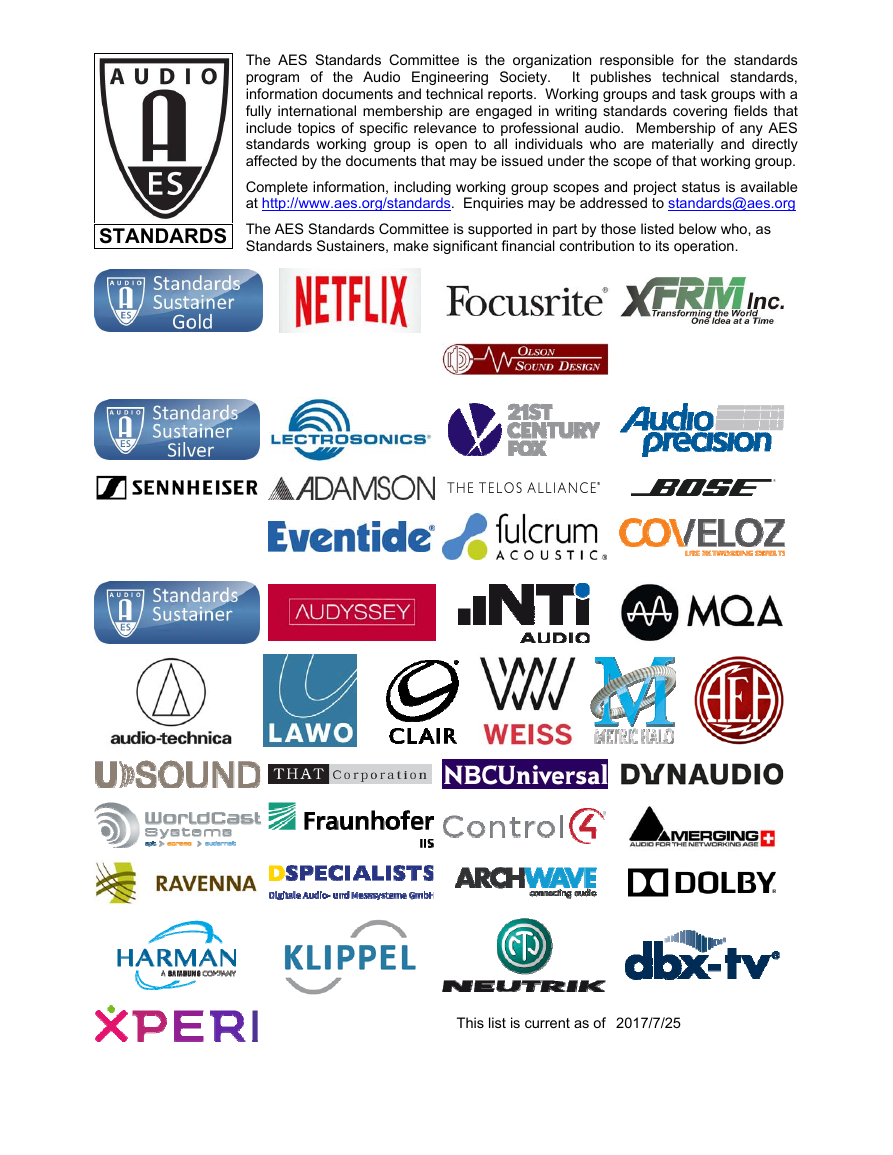
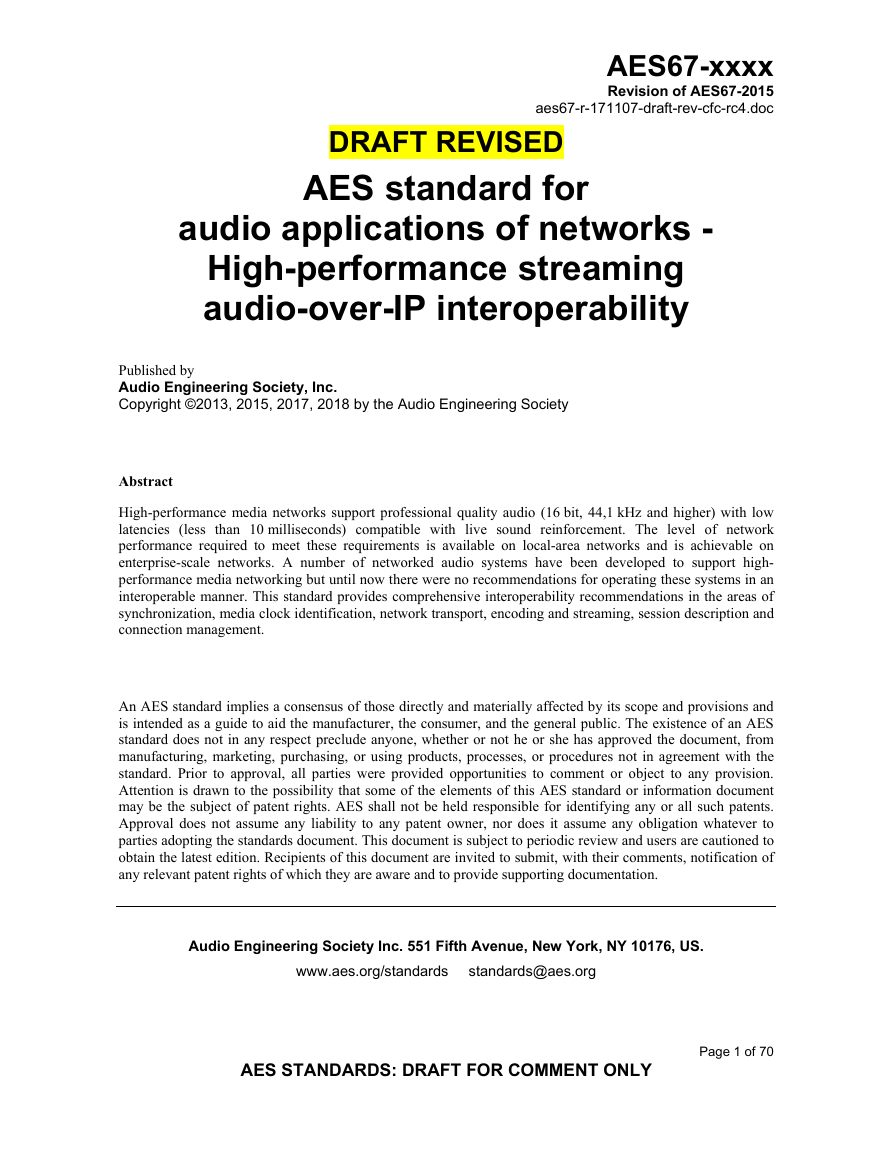

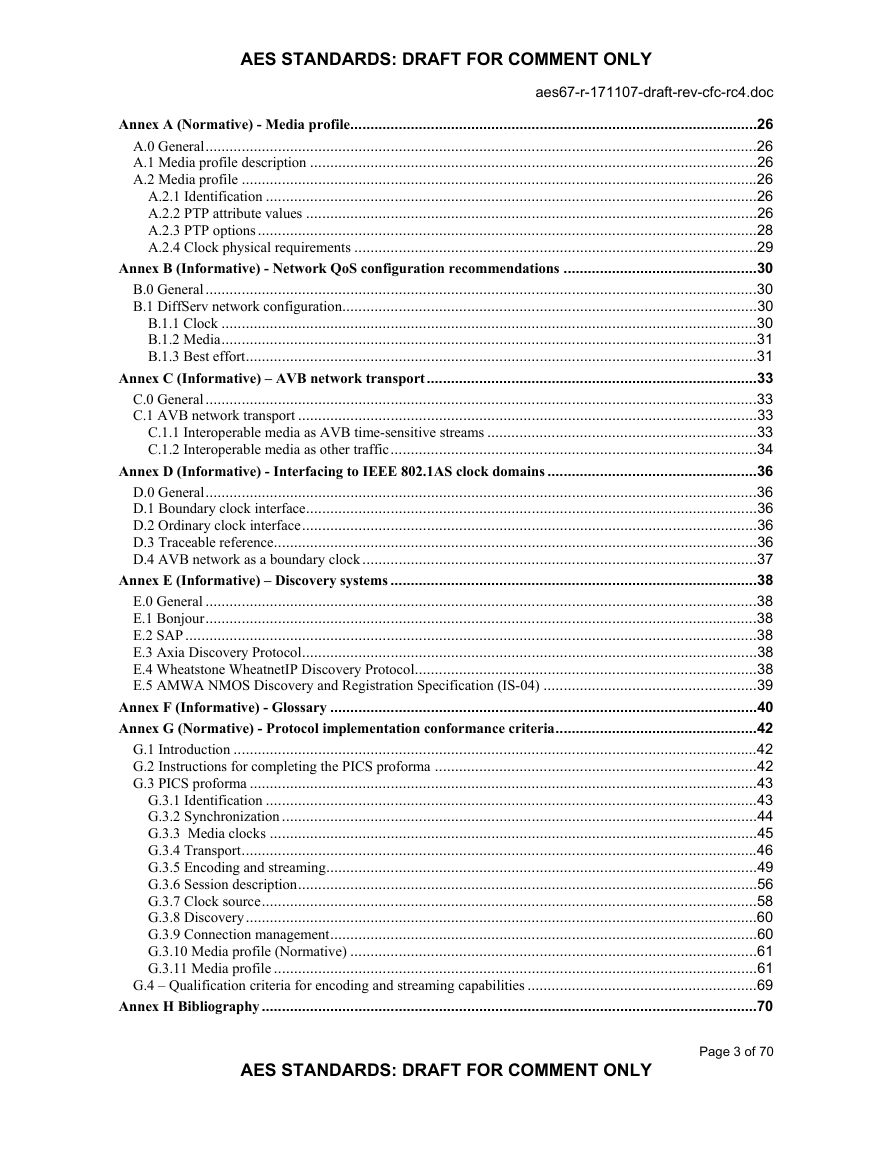

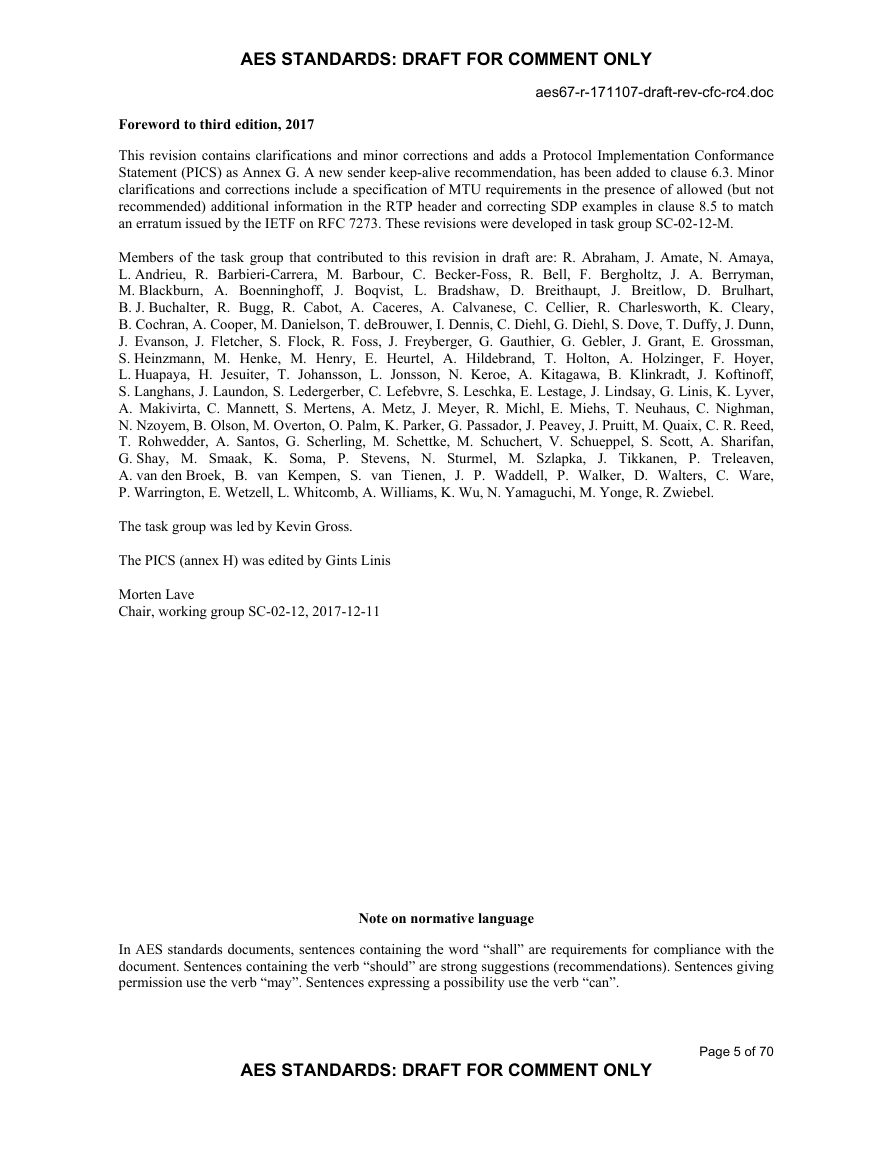
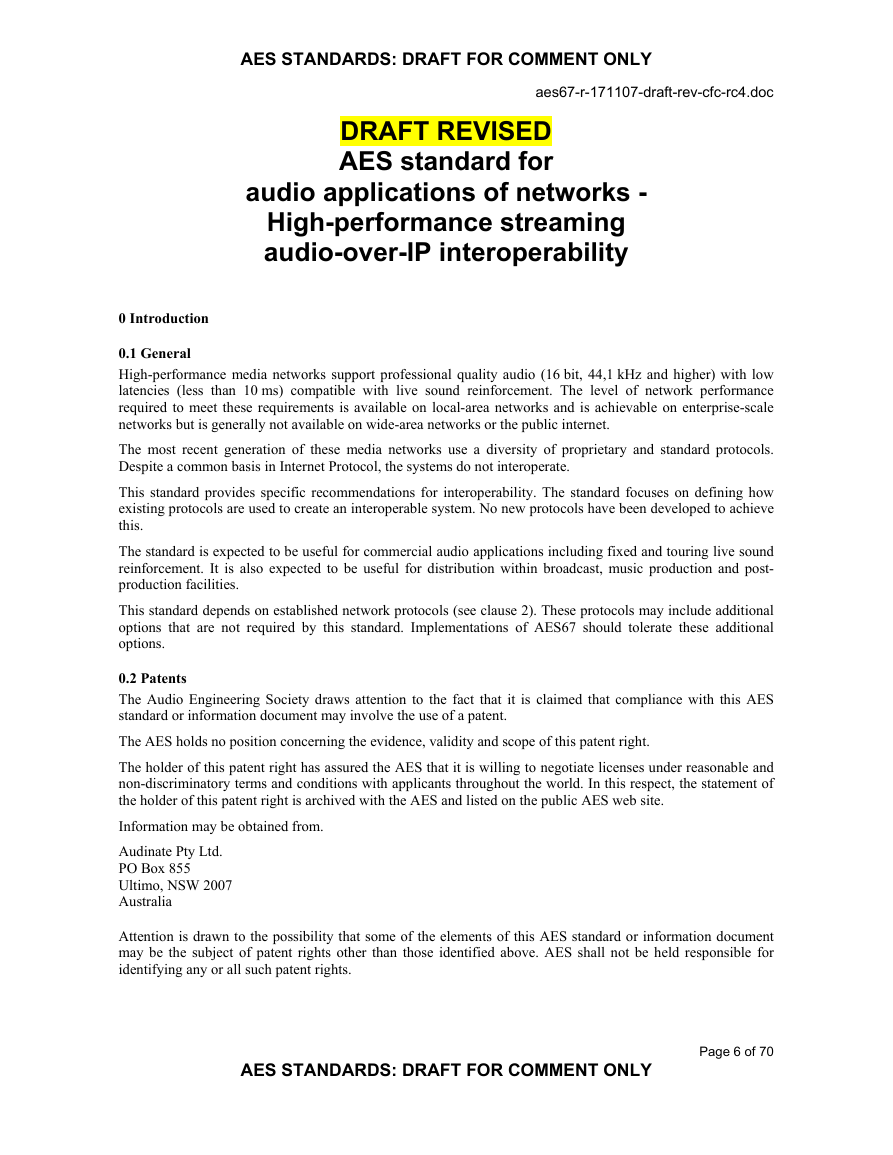








 2023年江西萍乡中考道德与法治真题及答案.doc
2023年江西萍乡中考道德与法治真题及答案.doc 2012年重庆南川中考生物真题及答案.doc
2012年重庆南川中考生物真题及答案.doc 2013年江西师范大学地理学综合及文艺理论基础考研真题.doc
2013年江西师范大学地理学综合及文艺理论基础考研真题.doc 2020年四川甘孜小升初语文真题及答案I卷.doc
2020年四川甘孜小升初语文真题及答案I卷.doc 2020年注册岩土工程师专业基础考试真题及答案.doc
2020年注册岩土工程师专业基础考试真题及答案.doc 2023-2024学年福建省厦门市九年级上学期数学月考试题及答案.doc
2023-2024学年福建省厦门市九年级上学期数学月考试题及答案.doc 2021-2022学年辽宁省沈阳市大东区九年级上学期语文期末试题及答案.doc
2021-2022学年辽宁省沈阳市大东区九年级上学期语文期末试题及答案.doc 2022-2023学年北京东城区初三第一学期物理期末试卷及答案.doc
2022-2023学年北京东城区初三第一学期物理期末试卷及答案.doc 2018上半年江西教师资格初中地理学科知识与教学能力真题及答案.doc
2018上半年江西教师资格初中地理学科知识与教学能力真题及答案.doc 2012年河北国家公务员申论考试真题及答案-省级.doc
2012年河北国家公务员申论考试真题及答案-省级.doc 2020-2021学年江苏省扬州市江都区邵樊片九年级上学期数学第一次质量检测试题及答案.doc
2020-2021学年江苏省扬州市江都区邵樊片九年级上学期数学第一次质量检测试题及答案.doc 2022下半年黑龙江教师资格证中学综合素质真题及答案.doc
2022下半年黑龙江教师资格证中学综合素质真题及答案.doc